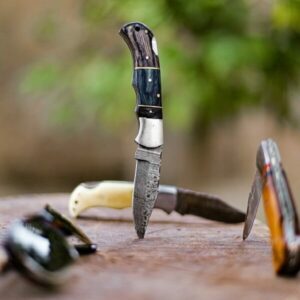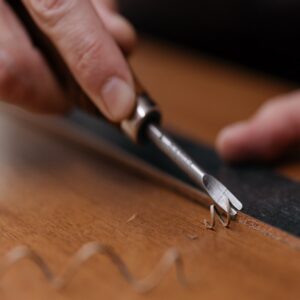If you’re a woodcarver, then you know the importance of preserving your work. You are investing a lot of time and effort into each piece, but you also want them to last for years to come. In this blog post, we will discuss some tips and tricks for preserving your wooden works for as long as possible.
So you just finished with a beautiful carving and you want to make sure it lasts. The are several things you can do to help preserve your work.
Seal The Wood
The first and most important thing is to seal the wood. There are a variety of sealants on the market, both commercial and homemade. You can use anything from polyurethane to lacquer to wax. The key is to make sure the sealant is compatible with the type of wood you are using. If you are not sure, do some research or test it on a small piece of wood before applying it to your masterpiece.
Choose The Sealer Type Based On Your Wood Type
Different sealants work better on different types of wood. For example, polyurethane is great for hardwoods like oak or maple, but it can be too brittle for softer woods like pine. In general, lacquer is a good all-around sealant for most types of wood, and it dries quickly so you can get back to work.
Wax is a great sealant for woods that are prone to cracking, like olive or walnut. It will help to keep the wood flexible and prevent cracking.
The Types Of Sealers
There are two types of sealants- surface sealants and penetrating sealants. Surface sealants form a protective barrier on the surface of the wood. This prevents moisture from getting in and causes the wood to expand and crack. Penetrating sealants, on the other hand, soak into the wood, filling in any cracks or pores. This prevents the wood from drying out and cracking.
Which Type Of Sealer Should I Use?
This depends on the type of wood you are using and the climate you live in. If you live in a dry climate, a penetrating sealant is best. If you live in a humid climate, a surface sealant is better. You can also use a combination of both types to get the best results.
Penetrating Sealer: Best For Dry Climate
Penetrating sealants are a great option for carvers who live in dry climates. They soak into the wood, filling in any cracks or pores and preventing the wood from drying out and cracking. They can also be used on all types of wood, making them a versatile choice.
types of penetration sealers
Oil-based sealers
These are the most common type of penetrating sealers. They are easy to apply and come in a variety of colors. However, they can be toxic if ingested and they can also be flammable.
Water-based sealers
These are less toxic than oil-based sealers and are non-flammable. However, they can be more difficult to apply and they may not be as durable.
Solvent-based sealers
These are the most durable of all the penetrating sealers. They are also the most expensive and the most toxic. They should only be used on non-toxic woods.
Apply A Finish
Once the wood is sealed, you can apply a finish. This will not only protect the wood from moisture and dirt, but it will also give it a nice shine and make it more resistant to scratches. There are many different types of finishes to choose from, so find one that suits your style and the type of wood you are using.
Surface Sealer: Best For Humid Climate
When it comes to sealing your wood carvings, a surface sealer is the best option for humid climates. This will help to repel moisture and keep the carving in perfect condition. There are many different types of surface sealers on the market, so be sure to do your research and find the right one for your needs.
Types Of Surface Sealers
Varnish
Varnish is a type of surface sealant that comes in both oil and water-based formulas. It is a great option for carvings that will be displayed in a humid environment, as it helps to protect the wood from moisture and humidity. It is also available in matte, satin, and gloss finishes.
Shellac
Shellac is also a great option for carvings that will be displayed in a humid environment. It is available in both an alcohol and water-based formula. It dries quickly and is very durable. However, it can be difficult to apply.
Polyurethane
is the best way to seal your wood carvings. It’s a spray-on sealant that comes in different finishes, including gloss, semi-gloss, and matte.
The great thing about polyurethane is that it will protect your carving from the weather and also make it resistant to staining. Make sure to apply at least two coats for the best protection.
Wax
Another option is to use a wax sealant. This will give your carving a nice, shiny finish and also help to protect it from the elements. Waxes can also be applied in different colors, so you can choose the one that best suits your carving. Just make sure to apply it regularly, as the wax will wear off over time.
Oil Sealant
If you want to give your carving a more natural look, you can use an oil sealant. This will help the wood to breathe and won’t make it shiny like wax. However, it will need to be applied more often than wax and it’s not as durable.
Danish Oil
Danish oil is a type of sealant that is made from vegetable oils. It is available in both an oil and water-based formula. It is easy to apply and it gives the wood a beautiful, natural finish.
Decking Oil
Decking oil is a type of sealant that is made for outdoor use. It is available in both an oil and water-based formula. It is designed to protect the wood from the weather and it comes in a variety of colors.
Lacquer
Lacquers are a great way to seal your carving and make it shiny and durable. However, they can be a bit tricky to apply and you need to be careful not to use too much. Make sure you follow the instructions carefully and allow enough time for the lacquer to dry before using your carving.
Which Method Is Best For Me?
There are many different ways to seal your wood carvings, so it can be difficult to decide which one is best for you. The best way to decide is to test each method on a small piece of wood before applying it to your carving. This will help you to see how the sealant performs and which one gives you the best results.
How To Apply The Sealer On The Wood?
There are many different ways to apply a sealer to your wood carving. You can use a brush, a rag, or even a spray gun. However, the best way to apply it is with a foam paintbrush. This will help to get into all the nooks and crannies of the carving and ensure that the sealant is applied evenly.
Be sure to use a good quality brush, as cheap brushes will shed bristles and cause problems when applying the sealer.
How Often Should You Seal The Wood?
The frequency with which you need to seal your wood carving depends on the type of sealant you are using and the climate you are living in. If you are using a surface sealer, you will need to apply it every few months. If you are using a wax or oil sealant, you will need to apply it more often, at least once a month. And if you are using a lacquer, you will need to apply it every few weeks.
Check The Sealant Every Few Months
Once you have applied the sealant, be sure to check it every few months to make sure it is still in good condition. If you see any signs of wear or cracking, reapply the sealant as needed.
Apply The Sealant In Several Thin Layers
When you apply the sealant, be sure to do it in several thin layers. This will help ensure even coverage and will prevent the sealant from pooling or dripping.
Use A Good Quality Finish
A good quality finish is also important for preserving your wood carving. A good finish will help to protect the wood from moisture, sunlight, and other environmental factors. It will also help to keep the wood looking beautiful for years to come.
Make Sure You Cover All The Surface
When applying the sealant, be sure to cover all the surfaces of the wood. This will help to ensure that the carving is protected from the elements. If you miss a spot, the sealant will not be as effective and your carving may start to crack and decay.
Take Care When Handling Your Carving
Finally, it’s important to take care when handling your carving. Don’t bang it around or drop it, and be especially careful when transporting it. If you are going to be moving it from one place to another, use a good quality carrying case or box to protect it.
Keep It Out Of Direct Sunlight
One of the main enemies of wood is sunlight. The ultraviolet rays can damage the wood, causing it to fade and crack. If possible, try to keep your carvings out of direct sunlight. If they do need to be in the sun, make sure to apply a UV-resistant sealant to protect them from the rays.
Conclusion
One of the most important things you can do to preserve your wood carvings is to seal them. This will help protect the wood from moisture and other elements that could damage it. There are a few different types of sealers you can use, but we recommend using an oil-based sealer such as danish oil or decking oil.
Apply multiple coats of the sealer, making sure to wait a day between each coat. Reapply the sealer regularly in the first year – and only once per year after that. Be sure to cover all the surfaces of the wood and keep it out of direct sunlight.
Now that you know how to preserve your wood carving, it’s important to follow these tips and tricks for keeping it in perfect condition. By using the right sealants and finishes, you can protect your carving from the elements and keep it looking beautiful for years to come.









